Funds Raised to Date
Days Remaining in Fundraiser
Oysters Minted
Remaining Collectibles
Votes Cast
Votes Not Yet Cast
Current Leader
Donate / Mint an Oyster
Join the digital reef! By minting an oyster, you will be participating in an experiment in philanthropy. Net proceeds from the sale of oysters in “The Dorises - Oystercraft from silicon to saltwater” project will go to one of three deserving oyster projects that focus on oyster conservation, education and job training, and cultural awareness.
Support this Fundraiser
Already own an oyster?
The deadline to vote is June 5, 2023 14:00 UTC+0 (9am New York, 11am São Paulo, 3pm Berlin, 10pm Shanghai).
Participating Initiatives
These three projects represent a range of approaches to reef conservation, and in all instances, connect human and oyster lives in order to create dynamic, equitable ecosystems.

Tending Ostreidae: Serenades for Settling
Tending Ostreidae: Serenades for Settling (TOSS) is an immersive, multimedia operetta created from the science and folklore surrounding the heroic oyster - its role as a vital organism of our ecosystems and its myth as a human aphrodisiac. Based on new studies investigating oysters’ need to “listen” in order to thrive, which points to hazardous interference caused by human-produced noise, (TOSS) advocates for sonically safe harbors for oyster communities and the ecosystems they inhabit. The operetta comprises a physical installation of sound, real-time data, and visuals; live participatory performances; and educational and community programming.
The creators: Stephanie Rothenberg’s interdisciplinary art draws from digital culture, science and economics to explore symbiotic relationships between human designed systems and biological ecosystems. Suzanne Thorpe is a sound artist and scholar who applies feminist and ecological theory to craft immersive sound engagements that question circulations of power within human and nonhuman systems.
Website:Tending Ostreidae
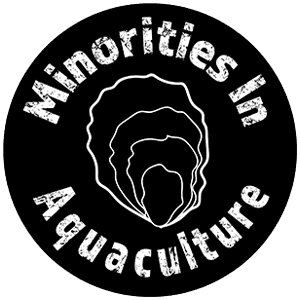
Minorities in Aquaculture (MIA)
Minorities in Aquaculture (MIA) is a community that works to educate underrepresented demographics about the environmental benefits provided by local & global aquaculture in order to promote a more diverse, inclusive aquaculture industry. MIA’s vision is to build the dialogue between minority communities and sustainable seafood by providing avenues of education/outreach approaches, career development opportunities like their internship program, funding support and other necessary resources to mitigate the common barriers of engagement that underrepresented groups in aquaculture face. Minorities in Aquaculture educates women of color on the environmental benefits of aquaculture and supports them as they launch and sustain their careers in the field, growing the seafood industry and creating an empowering space for women along the way.
Website: Minorities in Aquaculture (MIA)
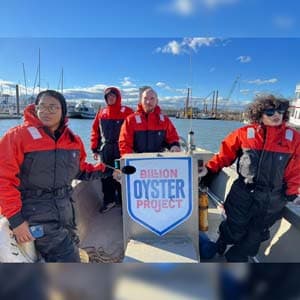
Billion Oyster Project and The New York Harbor School
Billion Oyster Project provides The New York Harbor School, a public high school on Governors Island, with real-world training for careers in marine and maritime industries. Through the school’s Career and Technical Education (CTE) programs, Billion Oyster Project staff act as advisors to students. As sophomores, students enroll in one of seven CTE programs — leading to industry certification. The experience includes a continuum of work-based learning, and Billion Oyster Project provides paid internships and other opportunities for practicing skills, like growing algae to feed oysters or designing underwater reef structures.
Varieties of Oysters
Embedded across the four categories are fifteen unique oyster "suprises," with varying degrees of rarity.
While the outsides of the oyster shells are similar, each of the 100 oysters in the edition is varied. The insides are structured through custom generative software and AI according to four categories, each based on an aspect of oyster physiology, purpose, and lore: Oyster Engineer (plumbing, cleaning, sifting, filtering machinery); Oyster Artist (creating beauty, wonder, inspiration, well-being); Oyster Sex Symbol (aphrodisiacal and sex-changing); and Oyster Kin (with other animals, including humans who “farm” and eat them).
“Rarity” refers to how many of each specific oyster type exist among the 100 oysters. The lower the percentage number, the rarer the specific contents.
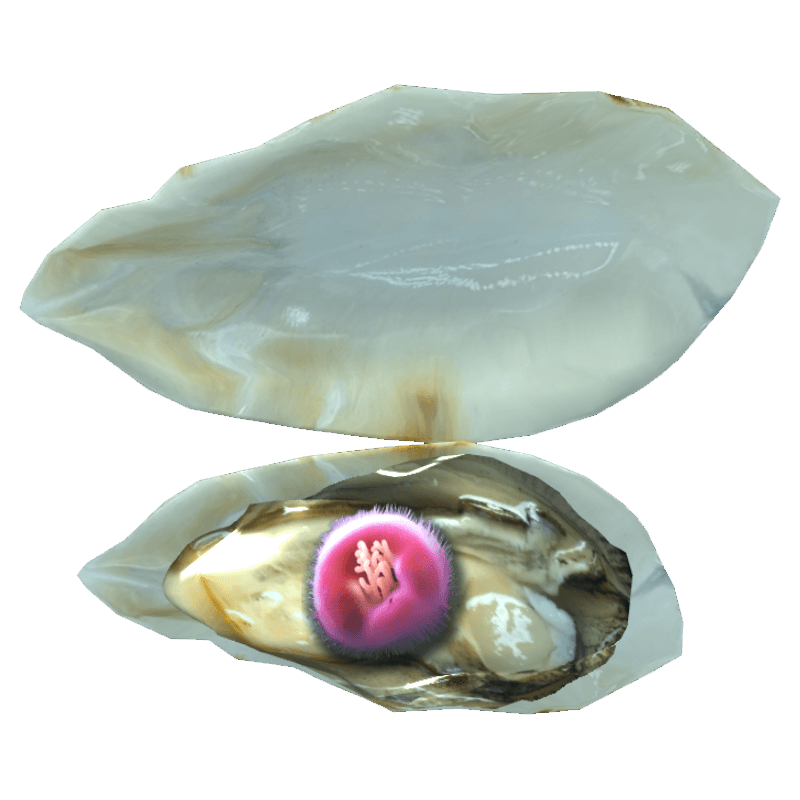
Anemone
| Category | Rarity | Actual Population in Reef |
|---|---|---|
Kin | 15% | 0 |
Oysters as Kin: Oyster reefs create important habitat for hundreds of species. Organisms like mussels, barnacles, and sea anemones settle on them, creating abundant food sources for commercially valuable fish. Oyster reefs provide habitat to forage fish, invertebrates, and other shellfish. Source: NOAA
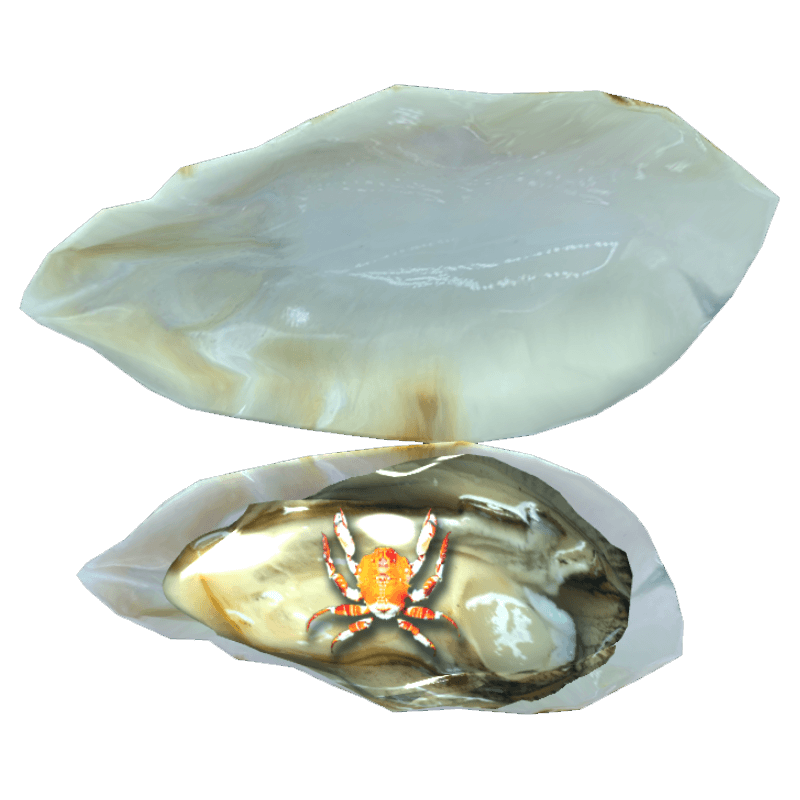
Crab
| Category | Rarity | Actual Population in Reef |
|---|---|---|
Kin | 12% | 0 |
Oysters as Kin: Oyster reefs create important habitat for hundreds of species. Organisms like mussels, barnacles, and sea anemones settle on them, creating abundant food sources for commercially valuable fish. Oyster reefs provide habitat to forage fish, invertebrates, and other shellfish. Source: NOAA
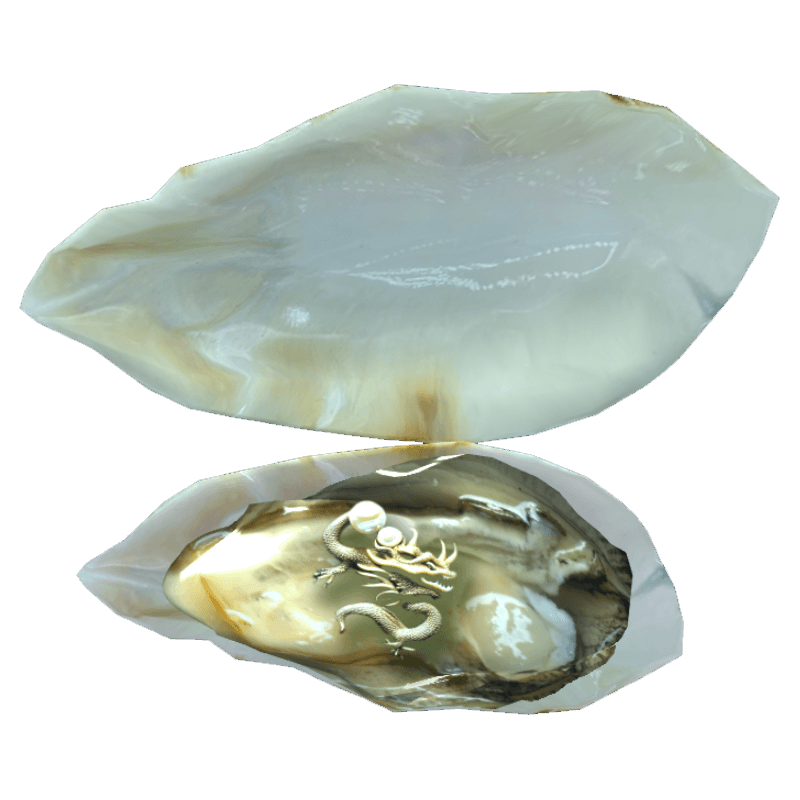
Dragon Pearl
| Category | Rarity | Actual Population in Reef |
|---|---|---|
Artist | 10% | 0 |
Oysters as Artists: Oysters are the first gems, and the only ones made by animals. According to an array of myths, Pearls were created when a rainbow met the earth after a storm (Persia); Pearls are formed when raindrops filled with moonlight fall into the sea and are swallowed by oysters (UAE); Pearls are dewdrops from heaven (India); Pearls are tears of joy shed by Aphrodite (Greece); Pearls are amulets against fire (China); Pearls Originate in the brain of the dragon (China); Pearls are luminous enough to be seen 3 miles away (China); In a show of unyielding power and wealth, Cleopatra dissolved a pearl into her goblet of wine. “Gems of the sea, which resemble milk and snow” (poet Manlius, Rome)
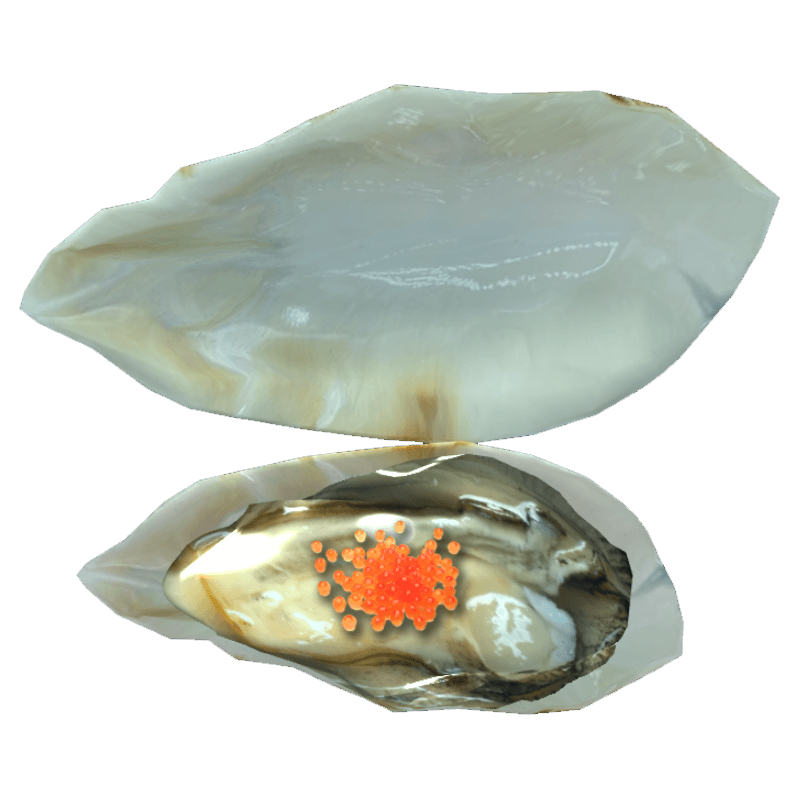
Eggs
| Category | Rarity | Actual Population in Reef |
|---|---|---|
Kin | 8% | 0 |
Oysters as Kin: Oyster reefs create important habitat for hundreds of species. Organisms like mussels, barnacles, and sea anemones settle on them, creating abundant food sources for commercially valuable fish. Oyster reefs provide habitat to forage fish, invertebrates, and other shellfish. Source: NOAA
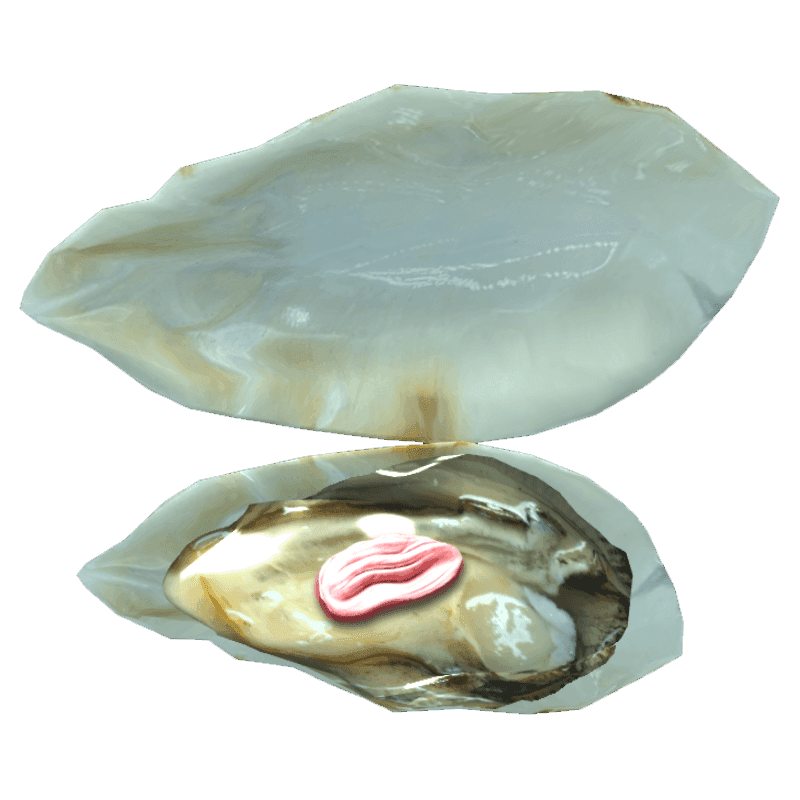
Female Genitalia
| Category | Rarity | Actual Population in Reef |
|---|---|---|
Sex Symbol | 20% | 0 |
Oysters as Sex Symbols: Oysters’ benefits are many when it comes to overall health and especially sexual health. Raw oyster has long been praised as an aphrodisiac. According to the research of Dr. Max Lake, their subtle, salty and briny scent is similar to a sex pheromone. Oysters were designated as sexual stimulants in ancient Chinese medicine specifically when they were eaten fresh and raw, and were cultivated in saltwater ponds for this purpose. Romans also began cultivating oysters in 103 B.C. for the purpose of feeding both physical hunger and sexual appetites. In Roman culture, oysters were referenced as a food of Bacchanalian orgies. The infamous Casanova boasted to have eaten fifty at breakfast together with a lady of his fancy. European painters used the oyster as a symbol of fertility and sexual pleasure.
Source: Eat Something Sexy
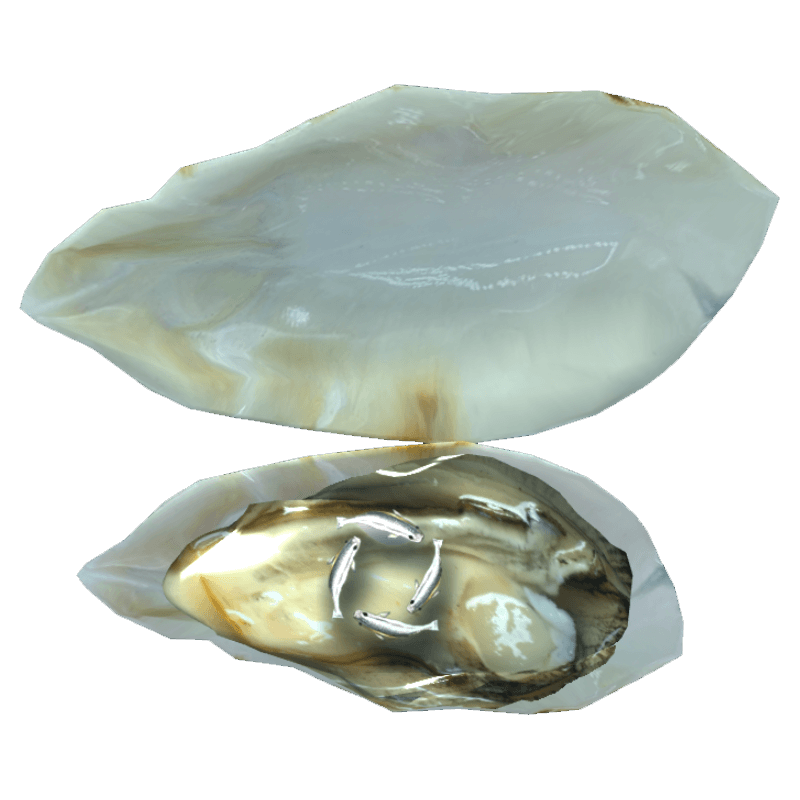
Fish
| Category | Rarity | Actual Population in Reef |
|---|---|---|
Kin | 15% | 0 |
Oysters as Kin: Oyster reefs create important habitat for hundreds of species. Organisms like mussels, barnacles, and sea anemones settle on them, creating abundant food sources for commercially valuable fish. Oyster reefs provide habitat to forage fish, invertebrates, and other shellfish. Source: NOAA
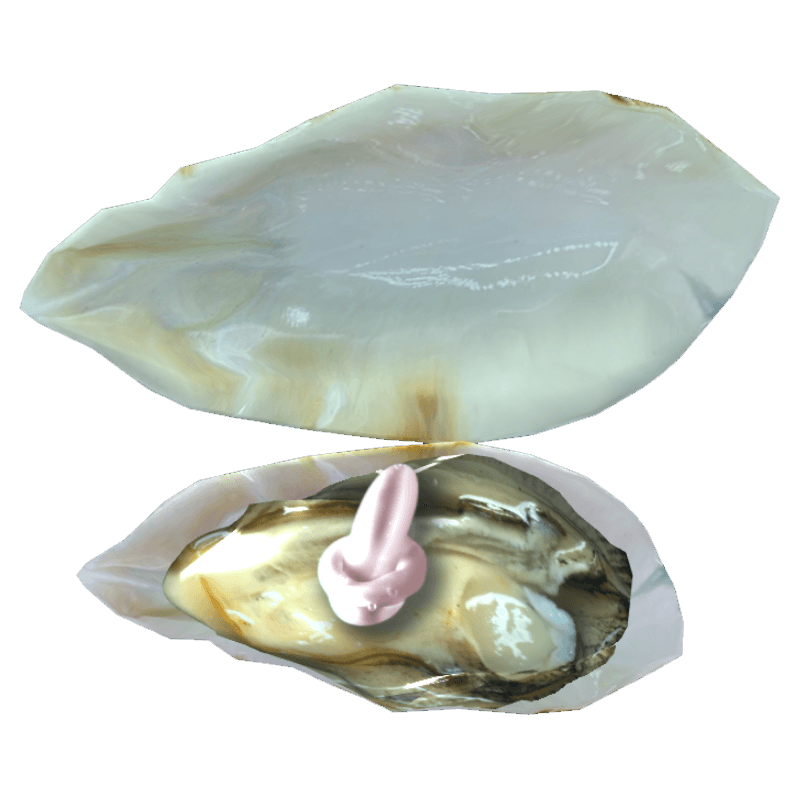
Male Genitalia
| Category | Rarity | Actual Population in Reef |
|---|---|---|
Sex Symbol | 20% | 0 |
Oysters as Sex Symbols: Oysters’ benefits are many when it comes to overall health and especially sexual health. Raw oyster has long been praised as an aphrodisiac. According to the research of Dr. Max Lake, their subtle, salty and briny scent is similar to a sex pheromone. Oysters were designated as sexual stimulants in ancient Chinese medicine specifically when they were eaten fresh and raw, and were cultivated in saltwater ponds for this purpose. Romans also began cultivating oysters in 103 B.C. for the purpose of feeding both physical hunger and sexual appetites. In Roman culture, oysters were referenced as a food of Bacchanalian orgies. The infamous Casanova boasted to have eaten fifty at breakfast together with a lady of his fancy. European painters used the oyster as a symbol of fertility and sexual pleasure.
Source: Eat Something Sexy
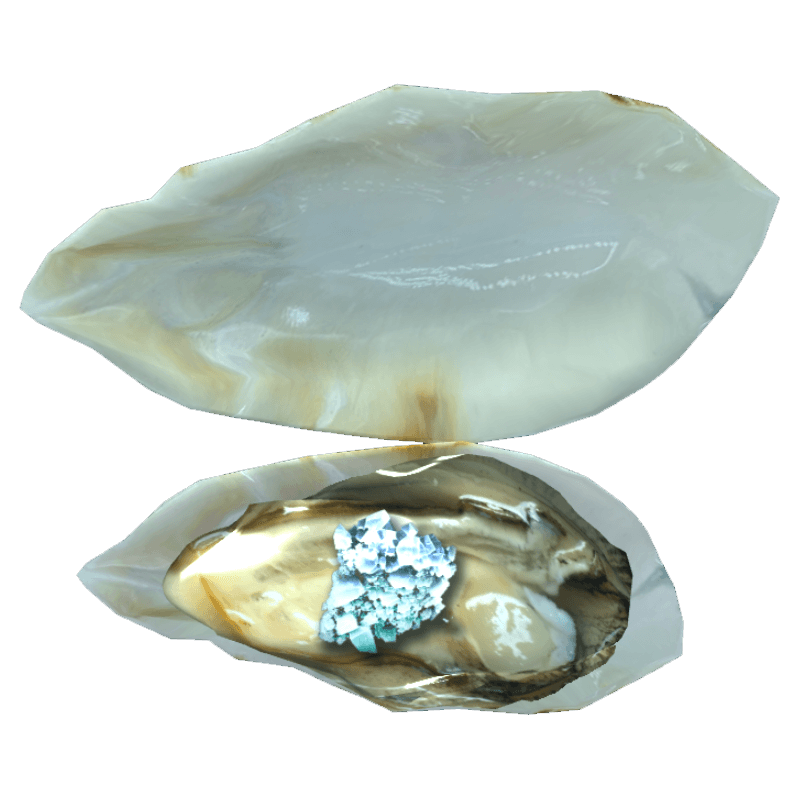
Minerals
| Category | Rarity | Actual Population in Reef |
|---|---|---|
Sex Symbol | 20% | 0 |
Oysters as Sex Symbols: Oysters’ benefits are many when it comes to overall health and especially sexual health. Raw oyster has long been praised as an aphrodisiac. According to the research of Dr. Max Lake, their subtle, salty and briny scent is similar to a sex pheromone. Oysters were designated as sexual stimulants in ancient Chinese medicine specifically when they were eaten fresh and raw, and were cultivated in saltwater ponds for this purpose. Romans also began cultivating oysters in 103 B.C. for the purpose of feeding both physical hunger and sexual appetites. In Roman culture, oysters were referenced as a food of Bacchanalian orgies. The infamous Casanova boasted to have eaten fifty at breakfast together with a lady of his fancy. European painters used the oyster as a symbol of fertility and sexual pleasure.
Source: Eat Something Sexy
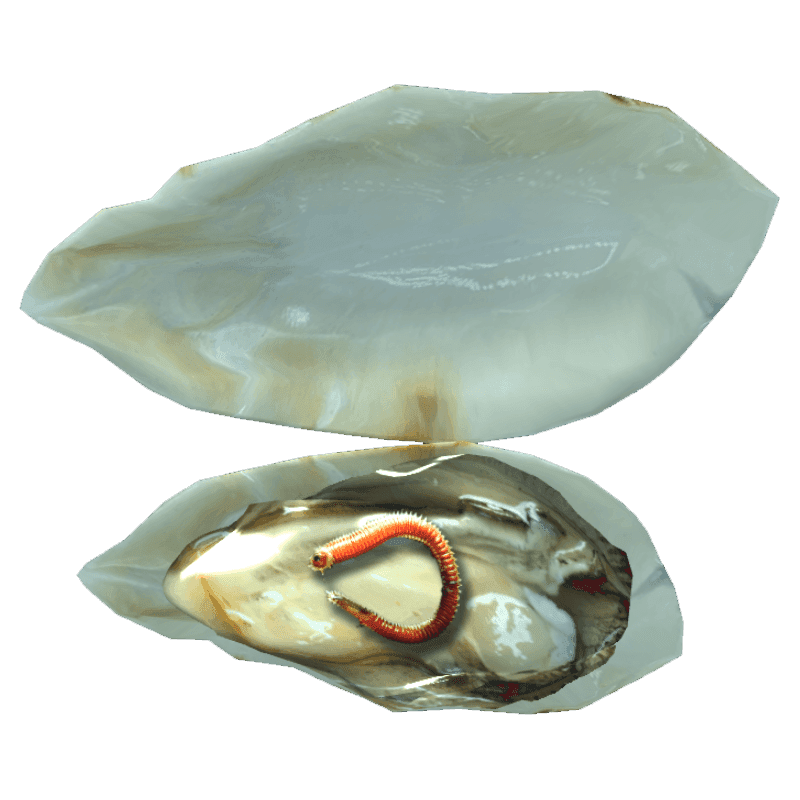
Mudworm
| Category | Rarity | Actual Population in Reef |
|---|---|---|
Kin | 12% | 0 |
Oysters as Kin: Oyster reefs create important habitat for hundreds of species. Organisms like mussels, barnacles, and sea anemones settle on them, creating abundant food sources for commercially valuable fish. Oyster reefs provide habitat to forage fish, invertebrates, and other shellfish. Source: NOAA
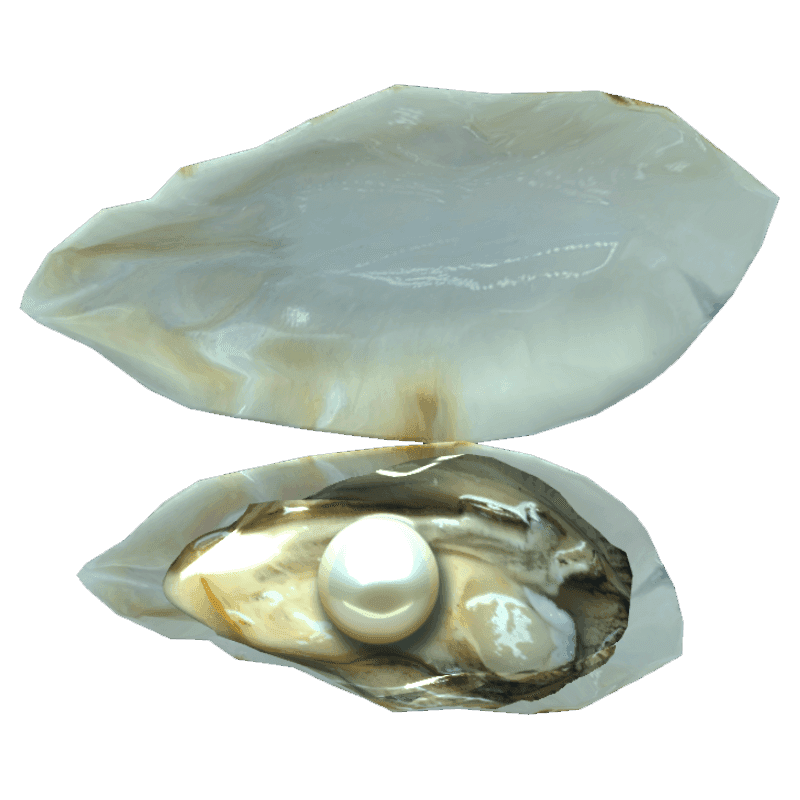
Pearl
| Category | Rarity | Actual Population in Reef |
|---|---|---|
Artist | 30% | 0 |
Oysters as Artists: Oysters are the first gems, and the only ones made by animals. According to an array of myths, Pearls were created when a rainbow met the earth after a storm (Persia); Pearls are formed when raindrops filled with moonlight fall into the sea and are swallowed by oysters (UAE); Pearls are dewdrops from heaven (India); Pearls are tears of joy shed by Aphrodite (Greece); Pearls are amulets against fire (China); Pearls Originate in the brain of the dragon (China); Pearls are luminous enough to be seen 3 miles away (China); In a show of unyielding power and wealth, Cleopatra dissolved a pearl into her goblet of wine. “Gems of the sea, which resemble milk and snow” (poet Manlius, Rome)
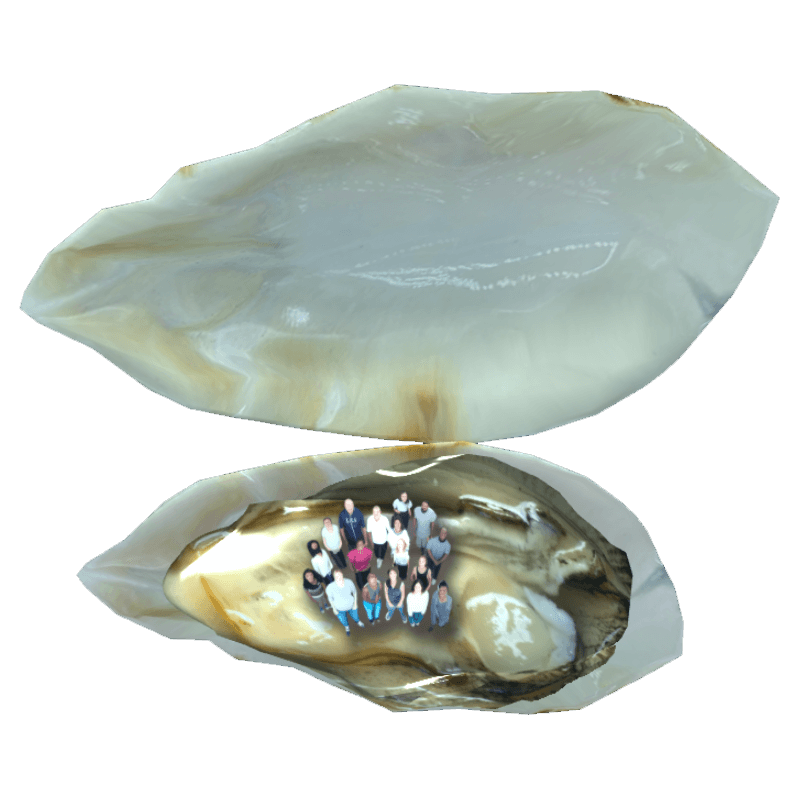
People
| Category | Rarity | Actual Population in Reef |
|---|---|---|
Kin | 20% | 0 |
Oysters as Kin: Oyster reefs create important habitat for hundreds of species. Organisms like mussels, barnacles, and sea anemones settle on them, creating abundant food sources for commercially valuable fish. Oyster reefs provide habitat to forage fish, invertebrates, and other shellfish. Source: NOAA
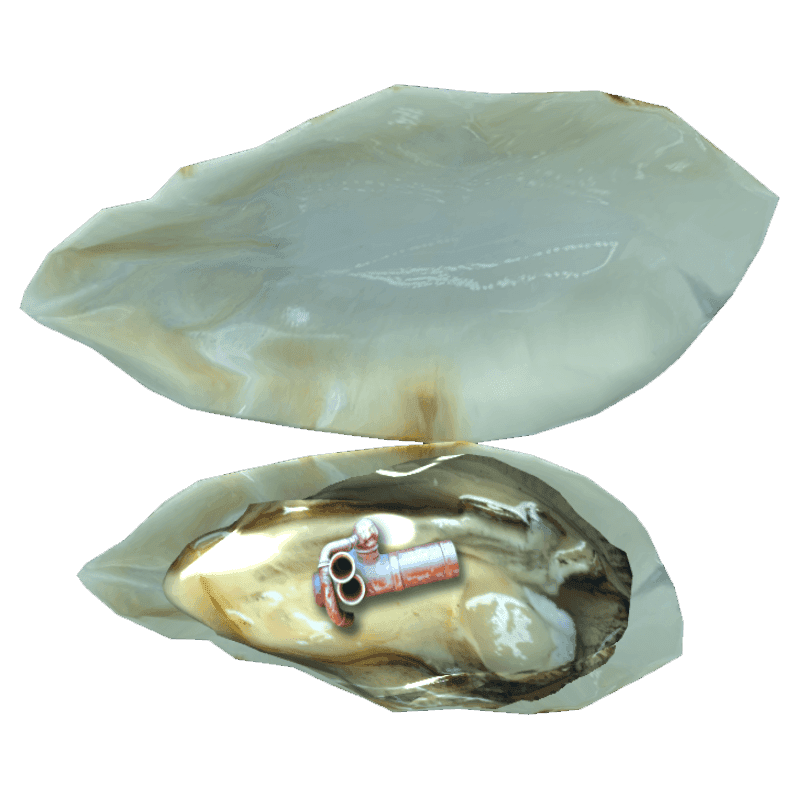
Pump
| Category | Rarity | Actual Population in Reef |
|---|---|---|
Engineer | 12% | 0 |
Oysters as Engineers: Oysters are keystone species because they have a disproportionately large impact on the natural environment and other species in an ecosystem. Oysters are also ecosystem engineers because they significantly modify and create new habitat for other species by forming reefs.

Rainbow Pearl
| Category | Rarity | Actual Population in Reef |
|---|---|---|
Artist | 5% | 0 |
Oysters as Artists: Oysters are the first gems, and the only ones made by animals. According to an array of myths, Pearls were created when a rainbow met the earth after a storm (Persia); Pearls are formed when raindrops filled with moonlight fall into the sea and are swallowed by oysters (UAE); Pearls are dewdrops from heaven (India); Pearls are tears of joy shed by Aphrodite (Greece); Pearls are amulets against fire (China); Pearls Originate in the brain of the dragon (China); Pearls are luminous enough to be seen 3 miles away (China); In a show of unyielding power and wealth, Cleopatra dissolved a pearl into her goblet of wine. “Gems of the sea, which resemble milk and snow” (poet Manlius, Rome)
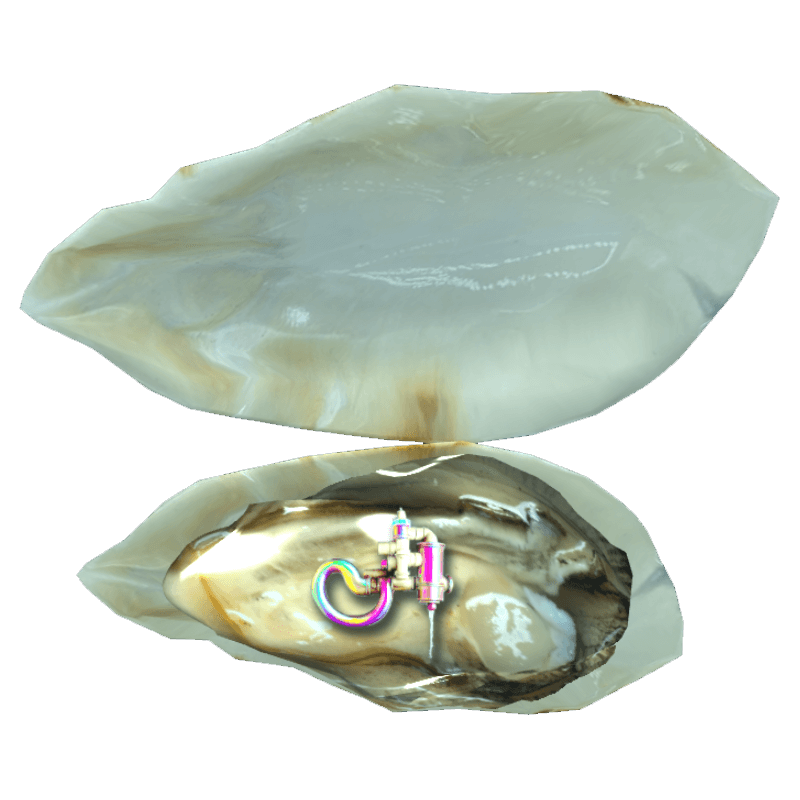
Rainbow Pump
| Category | Rarity | Actual Population in Reef |
|---|---|---|
Engineer | 10% | 0 |
Oysters as Engineers: Oysters are keystone species because they have a disproportionately large impact on the natural environment and other species in an ecosystem. Oysters are also ecosystem engineers because they significantly modify and create new habitat for other species by forming reefs.
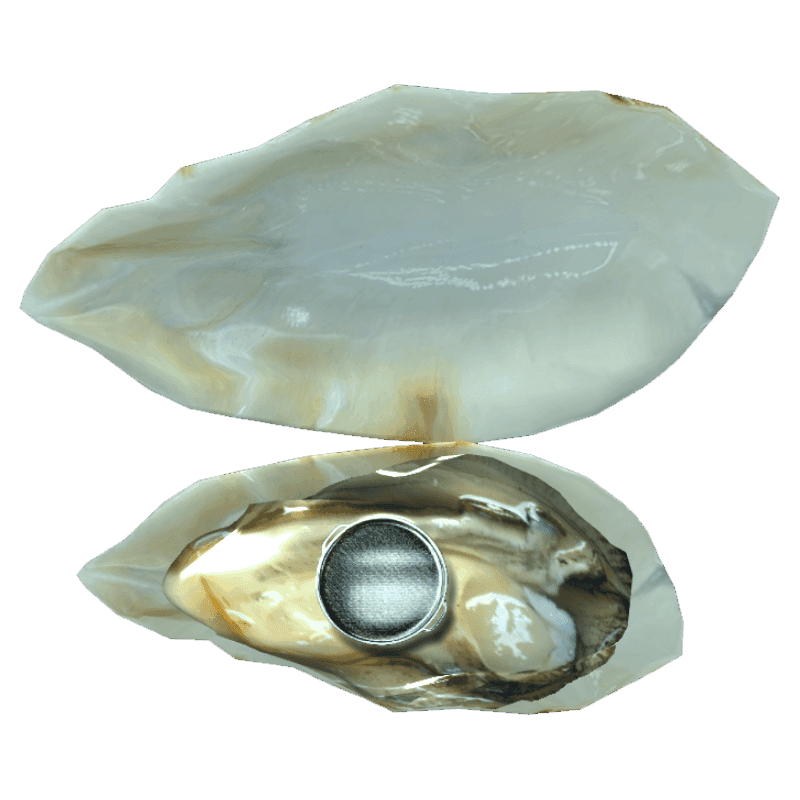
Sieve
| Category | Rarity | Actual Population in Reef |
|---|---|---|
Engineer | 15% | 0 |
Oysters as Engineers: Oysters are keystone species because they have a disproportionately large impact on the natural environment and other species in an ecosystem. Oysters are also ecosystem engineers because they significantly modify and create new habitat for other species by forming reefs.